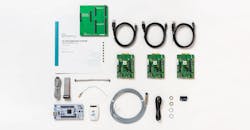Wireless IIoT Tech Seeks to Untangle Digital Revolution
If you're involved with manufacturing, there's a high probability you're getting inundated with reasons to collect more data, to become smarter, to connect everything to everything. The examples smack you in the face at tradeshows, clog your inbox and may even appear in this very article. So many actionable insights to be had. You're practically losing money by not doing it. It's really the only way to go.
Embracing the Industrial Internet of Things does make a lot of sense, and allows everyone from CEO down to operator to better understand and conduct operations, but there are incidental consequence to dealing when you do connect everything, specifically the mess of cables running all over the place. They allow your machines to stream torrents of data, but they can also make your factory floor look like the bottom of the Well of Souls from Raiders of the Lost Ark.
If you suffer from ophidiophobia (the fear of snakes), you can see why that could be problematic. If you fear downtime even more, drowning in miles and miles of cable causes even greater concern.
"Cables lack flexibility, and the maintenance and total cost of ownership can be pretty extensive," says Gabi Daniely, chief strategy officer at CoreTigo. The Israeli startup's overall mission is to "expand the industrial IoT revolution," which they plan to do by providing custom IO-Link Wireless network solutions for industrial mission critical applications. They connect sensors and actuators to PLCs as reliably and securely as the wired options. "What we're doing is basically unbinding the industrial space from cables."
The industrial areas that could benefit the most include robotic arms, large linear robots, mobile devices and machines in hazardous and hygenic environments.
Founded two years ago by former Apple and Texas Instruments employees, CoreTigo aims to decrease TCO and increase flexibility for industrial end-users and OEMs that require the IO-Link (IEC 61131-9) protocol.
And standardization will be a key factor to spur smart automation adoption and demystify a plant's digital transformation. The vast majority of IO-Link devices use M12 connectors, says the IO Consortium, making them easy to install and interface. Along with simplifying inventory and installation, it's easier to keep track of individual sensors, which all have an IO Device Description (IODD).
What makes CoreTigo interesting is that its wireless technology retains the benefits of the robust IO-Link performance of wired connections and nearly matches the latency, critical for accurate real-time understanding of machine data.
"It improves their solution's mean time between failures, and enables a more elegant and less cumbersome solution," Daniely says.
CoreTigo's solutions, deployed as plug-in dongles or printed onto PCBs, support a 5 msec latency between slave devices and the master, which can support up 40 devices. The communication has a range of 10 meters or more.
Compared to other wireless systems, Daniely says the reliability is six orders of magnitude better. Part of this is due to these smart connections using machine learning.
"We take advantage of the entire (2.4 GHz band) spectrum and do adaptive frequency hopping," says Daniely, a former Intel engineer. "Each transmission from the sensor is done on a different channel and bearing. It's always understanding and learning."
The available products include the TigoAir SOM (System on Module) that can be embedded inside a robot end-of-arm gripper or other devices, TigoBridge that externally connects to the sensor so it can talk to the master, and the TigoMaster that communicate with up to 40 IO-Link Wireless Devices simultaneously. The TigoStarter Developer's Kit allows users to test the Master, Bridge and devices connected to actuators or sensors to better acquaint themselves with the IO-Link Wireless tech.
The solution could drastically reduce the time and complexity it would take to increase data visibility in factory automation, material handling automation (mobile robots and automated storage and retrieval systems) and retrofitting legacy equipment to make dumb machine smart.
Pilots for the new solution are ongoing, and Siemens has nurtured CoreTigo in its Tel Aviv startup accelerator called Siemens Dynamo. In February, the promising company raised $10 million from Qualcomm Ventures and Sierra Ventures
"The rapidly evolving Industry 4.0 and Industrial IOT make CoreTigo's offering timely given their technology is targeting standard-based low power, low cost and robust wireless mission critical connectivity" said Boaz Peer, Director at Qualcomm Ventures for Qualcomm Israel Ltd. "We believe it has great potential to impact the industrial space along with technologies like 5G which Qualcomm is making possible."
About the Author
John Hitch
Editor, Fleet Maintenance
John Hitch, based out of Cleveland, Ohio, is the editor of Fleet Maintenance, a B2B magazine that addresses the service needs for all commercial vehicle makes and models (Classes 1-8), ranging from shop management strategies to the latest tools to enhance uptime.
He previously wrote about equipment and fleet operations and management for FleetOwner, and prior to that, manufacturing and advanced technology for IndustryWeek and New Equipment Digest. He is an award-winning journalist and former sonar technician aboard a nuclear-powered submarine where he served honorably aboard the fast-attack submarine USS Oklahoma City (SSN-723).

